|
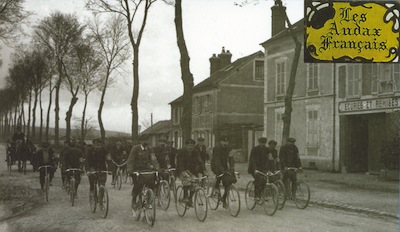
First official audax ride in France, April 1904
The Union
Des Audax Francais: An Abridged History
by Ken Dobb, based
on the book by Bernard Deon
I. Introduction
Randonneur cycling is an offshoot of an
older form of long distance cycling, something that might be
termed "Audax-style" cycling. Audax-style cycling is
long distance cycling in a single peloton - frequently organized
into a double pace line - at a moderate constant speed and under
the supervision of a ride captain. As is the case with randonneur
cycling, events take place on predetermined routes of fixed distances.
However, unlike randonneur cycling, Audax cyclists conform to
a predetermined ride schedule that is dictated by the average
speed the ride captain hopes to maintain. Randonneur cyclists,
by contrast, ride at a speed set by themselves. Groups are formed
as a matter of convenience, temporary alliances made on the road
with those of a similar fitness level.
In other respects, Audax cycling is very
similar to the randonneur model. Audax cyclists participate in
brevet rides, a brevet series comprising events of 200, 300,
400, and 600 kilometers. Just as the highest attainment of a
randonneur cyclist is the award of the Super Randonneur 5000
medal, so Audax cyclists strive to attain the Aigle d'Or which
has similar, though not identical, qualification requirements.
Among these requirements is the completion of Paris-Brest-Paris.
An Audax version of this event is held every five years, 2006
being the most recent edition. [note: a PBP Audax was held in 2011.]
Paradoxically, though randonneur cycling
is a derivative of the older Audax model, it is the newer style
of cycling that has retained control of the original organizational
expression of French long distance cycling - the Audax Club Parisien.
Audax cyclists, consequently, trace their origins not to the
founding of that club, but to the organization of the first Audax
brevet in France. This took place in Paris in April 1904. The
year 2004 thus marked the centenary year of the organization
of these events. To honour the occasion, M. Bernard Deon authored
a magisterial history of Audax cycling. His work, "Un Siecle
De Brevets d'Audax Cycliste" (self published, 2006), forms
the entire basis for what is written below: the following article
should be seen as a rough abridgement of M. Deon's finely detailed
research.
II. Origins And Early Years: 1904 -
1920
1. Cycle Tourism In France At The Commencement
Of The Twentieth Century
According to M. Deon, the origins of Audax
cycling can be attributed to the dissatisfaction of Henri Desgrange
with the state of cycle tourism in France at the 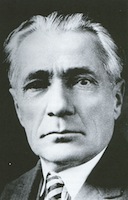 beginning of
the twentieth century. Since the 1890's, cycle tourism in France
had come under the sway of the Touring Club de France. This organization
was an affiliation of individual touring cyclists. These cyclists
belonged largely to hundreds of local clubs that, for the most
part, organized what might be termed "social cycling"
events, rides of short distances and an unchallenging nature,
ridden purely for pleasure. beginning of
the twentieth century. Since the 1890's, cycle tourism in France
had come under the sway of the Touring Club de France. This organization
was an affiliation of individual touring cyclists. These cyclists
belonged largely to hundreds of local clubs that, for the most
part, organized what might be termed "social cycling"
events, rides of short distances and an unchallenging nature,
ridden purely for pleasure.
At one point, all amateur cycling in France
had been organized under the auspices of the Union Velocipedique
de France. Since the emergence of the Touring Club, the interest
of the U.V.F. in cycle tourism had all but disappeared. A brevet
ride of 500 kilometers over five days was on the U.V.F. books,
but had fallen into disuse. Similarly, brevets of 50, 100, and
150 kilometers, originally designed as inducements for cycle
tourists, had turned into competitive time trials for racers.
What Desgrange was looking for was a way to revive these non-competitive
events, for a form of cycling that would prompt ordinary cyclists
to perform impressive feats of endurance.
Desgrange was, himself, a cyclist of repute.
Upon completion of his competitive cycling career he had been
recruited to assume the direction of the daily sport newspaper
L'Auto-Velo (shortly to become, simply, L'Auto), Under his direction,
this journal originated and assumed organizational responsibilities
for the Tour De France and became a powerful influence through
the breadth of French organized sport.
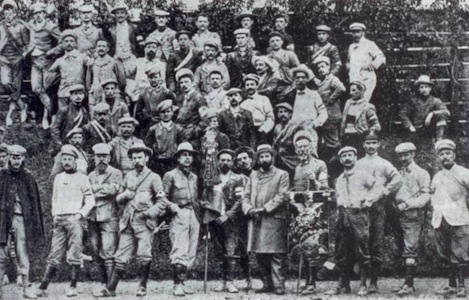
Vito Pardo and Audax Italiano, 1904
2. Audax Italiano
Desgrange found the style of cycling he
was searching for in the events organized by Audax Italiano.
In June of 1897, twelve Italian cyclists
left Rome for Naples to determine whether they could complete
the 231 kilometer distance in the daylight hours of a single
day. Nine riders finished the distance becoming the first group
of civilian long distance cyclists to complete a ride in the
Audax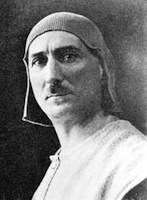 style. Some time later, a group of Neapolitan cyclists
performed the same feat in the reverse direction. At the banquet
celebrating the accomplishment of the twenty riders who had completed
the return journey successfully, the idea of creating an organization
of cyclists interested in riding distances of over 200 kilometers
was ventured. style. Some time later, a group of Neapolitan cyclists
performed the same feat in the reverse direction. At the banquet
celebrating the accomplishment of the twenty riders who had completed
the return journey successfully, the idea of creating an organization
of cyclists interested in riding distances of over 200 kilometers
was ventured.
At a meeting in Rome in January, 1898,
cyclists from all over Italy assembled and brought into being
Audax Italiano. Vito Pardo, who had captained the original ride
of the Roman cyclists to Naples, was elected President. Pardo,
an amateur sculptor, designed the original medal and diploma
that were awarded to each Italian cyclist who had completed an
organized 200 kilometer ride. By the end of 1898, Audax Italiano
was comprised of 12 sections and counted 244 cyclists as members.
By 1902, 1938 member cyclists were organized in 81 sections.
The organization continued its growth in the years before the
First World War, peaking at 7077 members in 214 sections in 1913.
A tradition of exchanging visits among
cyclists of different cities developed. In 1900, for instance,
Milanese cyclists organized four official rides of 200 kilometers.
In the same year, they traveled in groups to visit their counterparts
in Rome, Pisa, Monza and Lugano in Switzerland. Other members
of Audax Italiano ventured across the border into France, interesting
French cyclists - particularly those in Nice - in their activities.
3. 1904: The First French Brevets
Through 1901 and early 1902, Desgrange
ruminated in the pages of L'Auto-Velo on the state of cycle tourism
in France. In an editorial in August 1902, however, he advanced
an idea of cycle tourism based on groups led by ride captains
at a fixed moderate pace over distances of 150 to 200 kilometers.
Clearly, Desgrange was describing the cycling practiced by the
riders of Audax Italiano. At about this time, L'Auto-Velo began
to publish in its pages, without comment, announcements of the
planned ride programmes of the Italian organization.
In late 1903, L'Auto-Velo (or L'Auto as
it had now become) announced a planned excursion of the Turin
section of Audax Italiano to Paris in the following year. This
journey of 760 kilometers was projected to be completed over
four days. L'Auto undertook to arrange a reception of the Italian
cyclists on the road to Paris. At the same time, the journal
suggested that French cyclists organize themselves to conduct
long distance cycling on the Italian model.
In January 1904, Desgrange announced the
creation of a society of Audax cyclists in France. A first event
was planned for Easter Monday, April 3rd on a route between Paris
and Gaillon. Gaillon was located on the classic route between
Paris and Rouen that had been the course of the first inter-city
velocipede race in 1869. The village is the site of a particularly
difficult hill climb, chosen for this event as a test of the
mettle of the first participants of the new form of cycling.
Paris - Gaillon was to become a classic route for French Audax
cyclists, re-ridden on numerous occasions.
Four preparatory rides of progressively
increasing distances were held in anticipation of the April event.
These rides were all captained by Charles Stourm, a former racing
cyclist closely affiliated 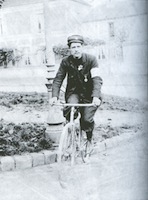 with L'Auto. In March, subscriptions
for the April event - limited to fifty places - were offered
at the offices of the newspaper. The places were all filled within
seven hours, with an additional fifty applicants turned away. with L'Auto. In March, subscriptions
for the April event - limited to fifty places - were offered
at the offices of the newspaper. The places were all filled within
seven hours, with an additional fifty applicants turned away.
On April 3rd, 37 cyclists gathered at the
Port Maillot in Paris at 3 a.m. Again under the leadership of
Stourm, the thirty finishers covered the 200 kilometer distance
in 16 hours. Discounting the 2 1/2 hour lunch stop in the town
of Vernon, their average speed was 15 kilometers an hour. The
finishers were the first to be accorded the status of Audax cyclists,
a designation that was reserved for those cyclists that had completed
an official ride of 200 kilometers. Each Audax designee was awarded
a diploma and a medal of yellow enamel by L'Auto, on which was
inscribed the unique number, in chronological order, assigned
to each Audax designee. Charles Stourm was awarded the accolade
of being designated Audax #1.
By the end of 1904, a further nine official
200 kilometer rides had been organized and successfully completed
in Paris. An additional 20 rides of 200 kilometers had been completed
in twelve other French cities. At year-end, 1018 cyclists had
been awarded the Audax designation. A highlight of the year was
the reception of 100 or so members of the Turin section of Audax
Italiano who had cycled to Paris in mid-July. Timed to coincide
with this event, a group of newly-designated Audax riders from
Lyons paid a return visit to Turin.
4. Formation of the Audax Club Parisien
On November 30, 1904, a meeting of interested
cyclists who had received the Audax designation met in a Parisian
cafe. The meeting was held on the initiative of Armand Le Rendu
(Audax #261) who was elected President of the newly formed club
- the Audax Club Parisien. The club was to be comprised exclusively
of those men who had received the Audax designation. Women who
had achieved the Audax designation were permitted honorary membership,
receiving the right to be full members only in 1912. Among the
sixteen founding members was Charles Stourm, adding by his presence
a certain gravitas to the new organization. Of significance for
the future of the organization, a proposal to add the word "Cycliste"
to the title of the association was rejected.
5. Development of a Cycling Programme
In the first years, official Audax brevet
rides were organized and conducted by cyclists affiliated with
L'Auto. This was equally true in the cities outside Paris, where
the newspaper's local correspondents took the task of organization
upon themselves. However, by 1906 this organizational responsibility
had been conferred on the A.C.P, with L'Auto acting solely in
the capacity of validating ride results. Beginning in 1907, the
official 200 kilometer rides began to be referred to as "brevet"
rides, the word "brevet" referring to the diploma that
was awarded to those who had completed the ride.
Between five and seven brevet rides of
200 kilometers were organized in Paris each year. This practice
continued even through the cycling seasons effected by the First
World War, those of 1915 through 1918. Equally, brevet rides
continued in a number of French provincial cities. The result
of this sustained activity was a steady growth in the numbers
of Audax cyclists - 2000 by August, 1907; 2741 by the end of
the 1909 season; more than 3500 at season end 1911; 4600 in April
1914 (the tenth anniversary of the initial 200 kilometer ride);
and 6000 by July 1918.
Almost immediately upon completion of the
first 200 kilometer rides, Audax cyclists sought to complete
longer distances. On May 28, 1905, the first 300 kilometer ride
- an event termed a "raid" in French - was attempted
by 11 members of the A.C.P. Ten riders finished the 316 kilometer
route in 22 hours and 30 minutes. In June 1908, 3 riders from
the Honfleur section in Northern France completed the first official
ride of 400 kilometers. The first Parisian 400 was completed
one month later by 20 cyclists in 23 hours, 30 minutes.
The A.C.P. scheduled one 300 kilometer
event and one 400 kilometer event from Paris each year, a practice
that was emulated by a number of the provincial sections. A rider
who successfully completed these rides was awarded a star to
add to the yellow enamel medal presented to Audax designees,
blue for completing a 300 kilometer ride, red for a completed
400 kilometer ride. Desgrange was sceptical of these newer distance
rides, considering them to be "a bit too long". While
he was willing to homologate the results of the 300 and 400 km
events, he declined to consider them as official Audax events,
leaving the organization and conduct of these events to the A.C.P.
The practice of cycle tourist excursions,
begun in Italy, was continued in the annual A.C.P. ride programme.
Periodic club excursions to a number of destinations in France
were scheduled throughout the pre-war years.
6. A Non-Cycling Audax Programme
Again in 1904, several months after the
first official 200 kilometer ride, the first official event of
Audax Pedestres was held under the auspices of L'Auto. The event
was modeled on its cycling counterpart. The event distance -
fixed by Desgrange at 100 kilometers, a distance decried as monstrous
by his contemporaries - was to be essayed under the control of
route captains. At the end of the two day walk, 64 successful
hikers received a diploma and a blue enamel medal to mark their
achievement and their designation as an Audax hiker. Through
time, a programme of official walks was established, with the
hikers elaborating their programme to include hikes of longer
distances - 130 and 150 kilometers. In August, 1905, a competing
organization of Audax designees was created - the Audax Club
de France. The goal of this organization was to group Audax cyclists
and hikers in one club. An event programme accommodating both
groups was established, but quickly the cyclists defected to
the A.C.P. The Audax Club de France became an organization exclusively
of hikers, to which, in time, Desgrange extended the responsibility
of organizing hiking brevets.
In 1913, A further Audax discipline was
added - swimming. In June of that year 10 swimmers entered the
Marne on the western periphery of Paris. They were attempting
to complete a distance of six kilometers within a three hour
time allowance. Among the seven finishers was Henri Desgrange
himself. Desgrange had already completed the required hiking
distance, and in 1912 had ridden his first 200 kilometer cycling
event. With the completion of the swim, he became the first person
to receive the Audax designation in each of the three disciplines
then extant.
A fourth discipline - rowing - was added
in 1921. The first brevet event of eighty kilometers, within
a time allowance of twelve hours, was held in September. Again,
Desgrange was among the sixteen participants who completed the
event. He chose, however, to downplay his participation. The
spotlight was instead shone on the accomplishments of Raphael
Boutin, who had now finished all eight Audax events (the three
cycling, three hiking, as well as the swimming and rowing brevets),
and who had, earlier in the year, assumed leadership of a new
organization of Audax cyclists.
III. Organizational Wars: 1913 - 1931
1. Introduction
Desgrange can be thought of as having three
design principles in mind in the creation of the Audax movement.
His aim, at the outset, was that the Audax movement be multi
disciplinary, embracing not simply cycling, but other sports
as well. Similarly, his intent was that the sports each be a
means to foster physical well being rather than a setting for
individual performance. In cycling, this meant wedding the pre-existing
brevet event structure to the disciplined group riding style
we now term "Audax". Third, he was a partisan of the
Union Velocipedique de France and believed that this organization
should be the sole organizing body for French cyclists. He opposed
the claims of the rival Touring Club de France to represent separately
the interests of touring cyclists.
Each of these three principles was subject
to a challenge by the cyclists organized under the rubric of
Audax cycling in the years just prior to, and following, the
First World War. This led to three organizational crises that
upset and split the Audax movement. Among other things, this
conflict led to the formal beginnings of randonneur cycling.
2. Schism 1913
The initial organizers of the Audax Club
Parisien intended that membership in the club be reserved for
those who had successfully ridden the 200 km official brevet
ride and had thus earned the Audax designation. In 1910, with
the resignation of Le Rendu as club president, this membership
rule was relaxed. The immediate consequence was an influx of
new members who were interested less in long distance cycling,
than in hiking and in shorter distance cycling excursions. Hiking
trips were initially introduced for the winter months. They proved
an immediate success. An initiative in 1912 to extend the hiking
programme to the summer months led to a harsh reaction from those
club members dedicated to distance cycling.
The club broke into two factions with quite
different views of the club's future. A working group attempted
without success to reconcile the differences between the contending
groups. At the January 1913 general meeting, two resolutions
expressing the opposing viewpoints were placed before the membership.
The resolution favoured by the long distance cyclists lost. The
majority group, those that favoured combining hiking activities
with cycling, by and large were uninterested in the Audax designation.
After some wrangling, the representatives of the majority group
decided to leave the organization of the Audax Club Parisien
in the hands of those club members who had a continuing interest
in the Audax designation and in participating in the club's long
distance rides. The members of the majority faction left to form
a new club, Les Francs Routiers. Their departure reduced membership
in the A.C.P. by about two-thirds. It also confirmed the mandate
of the club as committed to the promotion of the single sport
of long distance cycling.
For his part, Desgrange expressed no opinion
on this rupture save to reaffirm the role of the A.C.P. as the
organizer of official Audax brevet rides. Audax France continued
in its role of organizing the official Audax walking events.
3. Rupture 1921: The Beginnings of Randonneur
Cycling
Those who had led the response to the proposals
of the hiking group on behalf of the long distance cyclists would
be those who came to play an important part in the conversion
of the A.C.P. to the randonneur style of long distance cycling.
Among these was Louis Roudaire. Roudaire had been an editor at
L'Auto under Desgrange. His pronounced interest in bicycle tourism
led him to found his own journal in 1910 - Le Cyclotouriste.
It led him, as well, to a close association with the cycle tourist
movement known as the Ecole Stephanoise and with its spiritual
leader, Paul De Vivie.
The Ecole Stephanoise was an informal grouping
of touring cyclists who lived and worked largely in the St. Etienne
/ Lyon area of southeastern France. Participants in this grouping
were passionate advocates of the improvement of cycling technology.
Several made important design contributions to the advancement
of multi-gearing. The development of the derailleur, in particular,
benefited from the technical innovation of cyclists from this
group. Through his editorial contributions to his newspaper,
Le Cycliste, De Vivie played a key role in propagating interest
in bicycle technology, and in bicycle tourism more generally.
Le Cycliste also fostered the cycle tourist movement through
the promotion of periodic regional gatherings of its readers
at which technical developments were discussed.
Members of the Ecole Stephanoise practiced
a form of long distance cycling that was rooted in traditions
other than that of the disciplined group cycling that originated
with Audax Italiano. Increasingly after 1901, rides emphasising
cyclist performance were reported in the pages of Le Cycliste.
Among these were the annual rides undertaken each Easter by De
Vivie and his colleagues, from his home in St. Etienne over several
hundred kilometers to a predetermined destination in Provence.
These long distance rides presented an alternative model of long
distance cycling for key members of the A.C.P.
It was Roudaire who suggested the first
formal contact between the two groups. An initial meeting between
De Vivie, the A.C.P. and several provincial sections of Audax
riders was held at Nevers in 1908. Subsequently, Le Cycliste
organized annual regional meetings of riders from several Paris-area
cycling clubs at which members of the A.C.P. figured prominently.
After the 1913 rupture, the influence of
De Vivie's movement in the affairs of the A.C.P. became more
pronounced. Immediately after the announcement of the withdrawal
of the hiking members of the club, Roudaire, now named honorary
president of the club, announced that his newspaper would sponsor
a "polymultipliee". This was a sort of test of touring
bicycles or, more specifically, competing systems of multiple
gearing. The competition, held over a hilly course, was designed
to foster competition among bike and component manufacturers.
The A.C.P. provided material support both to this event and to
a second multiple gearing "championship" that was held
before the outbreak of the First World War.
Equally significantly, Roudaire introduced
changes in the Audax riding style. Under his presidency in 1910,
the club had introduced the use of control cards. Until this
point, the ride captain had held a roll call at each control
point along a brevet route, disqualifying those riders not present
for his call. It had been found, however, that some riders who
had been dropped by the main peloton, for one reason or another,
nevertheless reached the control within the official time limit.
The control card was introduced to enable these riders to record
their arrival time and to continue their ride.
Roudaire now took this a step further,
introducing control opening and closing times based on a 25 kph
maximum and an 15 kph minimum speed. This innovation, introduced
for the running of the 300 and 400 km brevets in 1913, marks
the unofficial beginnings of randonneur cycling. the club executive
was quite conscious of the change that was being made. The ride
regulations for that year contain the following comments:
"As much as it is easy to complete
in a peloton an outing of 200 kilometers under the direction
of a ride captain, it becomes difficult to hold together cyclists
over 300 kilometers, and still more difficult over 400 kilometers.
Competitors [sic] will manage their progress according to their
fitness, always provided that they take aim at the control opening
and closing times, arriving neither before nor after. As it is
advantageous to ride together in groups, rather than as isolated
cyclists, the competitors [sic] may form one or more pelotons
as they wish."
This is a marked departure from the formula
of a single group riding at a moderate speed under the control
of a ride captain that had been the norm for official Audax rides
up until this point. To further underline the departure, the
club executive announced that medals would be awarded to those
club riders who could establish new record times at each of the
300 km and 400 km distances.
The intervention of the First World War
led to a suspension of any discussion within the club that this
change might have provoked. A programme of official rides was
maintained on roads away from the war sector throughout the duration
of the conflict, despite the departure of much of the club leadership
for active duty. However, upon cessation of the hostilities,
the changes introduced by the Roudaire-led club executive became
a matter of controversy. Desgrange began not to publish announcements
of forthcoming rides of 300 and 400 kilometers that employed
the formula of opening and closing control times. A confrontation
between and Desgrange and the A.C.P. over this matter resulted
in the resignation of a member of the club executive in 1920.
Things came to a head in 1921. Some members
of the club were now advocating that the formula of opening and
closing control times be applied to 200 km brevet rides as well.
During the first official 200 km brevet ride of the season, on
April 10th, the ride captains set a very quick pace that soon
split the peloton. Many of those left behind regrouped behind
an impromptu ride leadership and finished the brevet at a moderate
pace. Subsequent to this event, Desgrange published a brief statement
in the pages of L'Auto withdrawing the responsibility for organizing
official Audax rides from the A.C.P. and once again conferring
this responsibility on his newspaper. A subsequent brevet ride
on April 22nd was held under the leadership of ride captains
of Desgrange's choice. Needless to say, Audax ride conventions
were observed during this event.
The withdrawal of the right to organize
Audax events left the leadership of the A.C.P. in a quandary.
After a period of some recriminations, the club regrouped and
announced the introduction of the "Brevets des Randonneurs
Francais". The first brevet ride under this rubric was a
200 kilometer event held on September 11, 1921.
There can be no doubt that other matters
contributed to this rupture. In the immediate aftermath of the
War the leadership of the T.C.F. proposed that a polymultipliee
event be held in the near future. As Roudaire's cycling journal
had disappeared during the war years, another sports journal,
a direct competitor of Desgrange's paper, took the task of promoting
this event upon itself. Again, the A.C.P. signed on to support
this event, but where A.C.P. participation in the past had not
provoked Desgrange's interest, club support of the 1921 event
prompted bitter recriminations. This matter, however, simply
added fuel to a fire that was already burning. The controversy
over the appropriate manner of conduct on official rides had
already created deep divisions among members of the club.
4. The Creation and Alignment of The Union
Des Audax Cyclistes Parisiens
The figure that emerged as the leader of
those disaffected with the randonneur riding style was the rather
corpulent one of Raphael Boutin. Too old for active service in
the war, Boutin had joined the A.C.P. during the 1914 season.
He had quickly accumulated the medals for the three official
Audax rides, and soon had become pressed into service as a ride
captain. He had lost this position in the 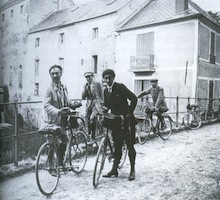 aftermath of the war's
end, but the experience stood him in good stead. It was Boutin
who had rallied those riders left behind by the ride captains
of the first brevet of the 1921 season, and it was to Boutin
to whom Desgrange turned to lead those riders who participated
in the brevet of April 22nd, the first organized without A.C.P.
participation. aftermath of the war's
end, but the experience stood him in good stead. It was Boutin
who had rallied those riders left behind by the ride captains
of the first brevet of the 1921 season, and it was to Boutin
to whom Desgrange turned to lead those riders who participated
in the brevet of April 22nd, the first organized without A.C.P.
participation.
Boutin took on the task of creating a new
club to carry on the organization of Audax brevets at Desgrange's
suggestion. As has been noted above, Boutin was among the first
to have received all the Audax awards in each of the four Audax
disciplines. His impulse was to create the new club along multi-disciplinary
lines. However, his overtures to the hiking organization - Audax
France - were not well received, with the consequence that Boutin's
new club became one exclusively for cyclists. The Union Des Audax
Cyclistes Parisiens was created in April, 1922.
The rupture proved to be far less calamitous
for the membership numbers of the A.C.P. than the earlier schism
of 1913. At an early founding meeting of the Union des Audax,
only four of the eleven members present had been members of the
A.C.P., the remainder largely being newly qualified Audax designees.
Members of each club began participating in the rides of the
other. Boutin himself went out of his way to avoid stirring enmity
between the two organizations. Among his conciliatory moves was
ensuring the membership of the Union des Audax in the federation
of bicycle touring clubs newly created by his harshest critic
in the A.C.P., Gaston Clement.
Clement had been a ride captain in the
first decade of the A.C.P. He had served on the A.C.P. executive,
and had been among the leaders of the club who had opposed the
diversification of the club into a hiking programme in 1913.
By 1920, Clement had become a member of the steering group of
the Touring Club de France. This organization, founded initially
by bicycle tourists, had changed in character through the years.
Especially after the advent of the automobile as a reliable mode
of transportation, the club had become more focused on purely
touring matters. The interests of bicycle tourists were increasingly
set aside in favour of the interests of tourists of more affluent
means. Clement worked within the T.C.F. to counter these trends.
Stepping into the shoes of Roudaire, it
was on Clement's initiative that the first post-war polymultipliee
had been organized under T.C.F. auspices . This event, held at
Chanteloup, became an annual fixture in the French cycling calendar
for many years.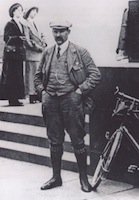 He took the idea of this event a step further
by organizing the first editions of a cycling week of friendly
competition for touring cyclists. The Semaine D'Auvergne held
in July 1922 was a test of 700 kilometers over five stages through
mountainous terrain. A second event in the Dauphinee region was
held in the subsequent year. A cycling week - La Semaine Federale
- has become an annual tradition for cycletourists in France. He took the idea of this event a step further
by organizing the first editions of a cycling week of friendly
competition for touring cyclists. The Semaine D'Auvergne held
in July 1922 was a test of 700 kilometers over five stages through
mountainous terrain. A second event in the Dauphinee region was
held in the subsequent year. A cycling week - La Semaine Federale
- has become an annual tradition for cycletourists in France.
In early December,1923, Clement hastily
called a meeting to create a new federation of bicycle tourist
clubs under the auspices of the T.C.F. Representatives of five
cycling clubs from the Paris area agreed to join together to
form the new organisation. Of the seventeen persons present,
eight were affiliated with the A.C.P. The Federation Francaise
des Societes de Cyclotourisme was officially brought into being
several days later. The U.A.C.P. was one of fifteen clubs represented
at the first F.F.S.C. general meeting in February, 1924. Clement
was elected president of the Federation, while Boutin was elected
as a member of the executive committee.
Clement's initiative was probably prompted
to head off some behind the scenes manoeuvring between the executives
of the T.C.F. and the U.V.F. Despite Clement's efforts, an accord
between the two organisations was announced in April 1926 that
gave effective control of cycle touring events to the U.V.F.
These events were to be placed in the hands of a cycle tourist
commission, the membership of which was to be selected by the
U.V.F. While clearly under the control of the U.V.F., the commission
was nominally part of the T.C.F. Some part of the intent of this
accord was clearly to drive the F.F.S.C. out of existence. Participation
in events sanctioned by the cycle touring commission of the T.C.F.
was open only to members of the U.V.F. or members of clubs and
societies associated with the U.V.F. Clubs affiliated with the
F.F.S.C. were required to drop that affiliation if the events
that they organized were to receive T.C.F. authorisation.
This accord seems to have had little immediate
effect on the U.A.C.P. In 1928, at the ceremony conferring the
10,000th Audax designation on the popular French racing cyclist
Eugene Christophe, the president of the F.F.S.C. was present,
as was Gaston Clement.
In 1930, however, Desgrange again withdrew
the right to organize Audax brevets from the club to which he
had previously entrusted the task. He now conferred that responsibility
on th U.V.F. The U.V.F. would not itself organize Audax brevets,
but would delegate this task on a regional basis to applicant
clubs. The U.C.A.P. was thus placed in a position where it felt
compelled to apply to the U.V.F. in order to continue its established
ride programme in the Parisian region. The U.C.A.P. eventually
took this step, but not without first exploring other options.
Among the casualties of this upset was the promising young president
of the club - Andre Griffe. Griffe appears to have made a deal
with Desgrange supporting the initiative, without the knowledge
or support of the club executive. The upset caused by Desgrange's
manoeuvre led to Griffe's resignation from the club. At the same
time, the club's membership in the F.F.S.C. was revoked.
In the ongoing struggle over the representation
of the interests of bicycle tourists, Desgrange was able to reassert
his belief that the interests of French cyclists were best served
through membership in a single organization - the U.V.F. As had
been the case with the style of riding adopted during the course
of Audax events, Desgrange had used his authority to reaffirm
the principles that had guided his initial creation of the Audax
movement.
IV. An Audax Ride Programme: Advance
and Recession 1921 - 1945
1. Reaffirming The Audax Cycling Style
The pre-war initiatives of the randonneur
cyclists in the A.C.P. had placed in doubt that the 300 and 400
kilometer events could be cycled in the customary Audax style.
Raphael Boutin saw as among the most important tasks he faced
in the direction of the new organization of Audax cyclists, the
re-establishment of these rides in the Audax ride programme.
An initial 300 km event was completed in 21 hours on June 18,
1921. Fifty-nine of the sixty-one cyclists who started the event
managed to finish, riding the moderate, controlled pace of the
Audax style. Similarly, twenty-one of forty-one starters finished
the 400 km ride held on July 23, 1921, again riding in the Audax
style.
Desgrange, who until this point had considered
these distances to be too long, conferred official brevet status
on these events for the first time. However, he refused an application
by the club to participate in Bordeaux - Paris, a race at that
time organized by his newspaper. This race, the oldest in the
professional race calendar, had been the object of attention
by Audax riders for some years. From the outset of the event,
amateur participation had been permitted in an event held in
parallel with the professional race. The proposal to Desgrange
was that an Audax ride be organized on the race route and run
in conjunction with the race. For his part, Desgrange wanted
to rigorously separate Audax cycling from any association with
racing.
This refusal left Boutin with a desire
to push the boundaries of Audax cycling. He looked to establish
an event of 600 kilometers, roughly the distance of Bordeaux
- Paris. He scouted the route, Paris - Dijon and return, that
was to become the standard 600 kilometer route for the club for
many years. Gaining Desgrange's reluctant agreement, Boutin organized
the first attempt at the 600 kilometer distance on August 5,
1922. Eleven of twelve starters completed the ride, one on a
fixed gear machine, establishing the event as an annual occurrence
in the Audax ride programme.
2. Paris - Brest - Paris 1931
The continuing success of Audax riders
at the 600 kilometer distance led members of the club executive
to look beyond, to the possibility of the participation of Audax
cyclists in Paris - Brest - Paris. This event, begun in 1891,
was considered to be the ultimate marathon challenge for 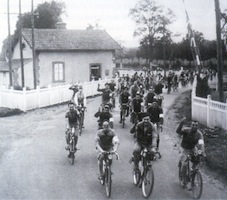 cyclists.
As was the case for Bordeaux - Paris, amateur participation had
been a feature of the event since its inception and, indeed,
a number of Audax club members had participated in past editions
as individual amateur entrants. cyclists.
As was the case for Bordeaux - Paris, amateur participation had
been a feature of the event since its inception and, indeed,
a number of Audax club members had participated in past editions
as individual amateur entrants.
Among those who looked to Paris - Brest
was Andre Griffe. Griffe had been a member of the U.A.C.P. executive
committee and was elected club president in 1928. In that year,
he opened negotiations with Henri Desgrange to stage a 1000 kilometer
event. Griffe clearly wanted to establish the 1000 km event to
strengthen his case for Audax participation in the 1931 edition
of P.B.P. Characteristically, Desgrange was reluctant. He denied
the 1000 km event any kind of official status. No medals or certificates
were to be awarded. However, he pledged the support of the local
correspondents of L'Auto to man controls along the proposed route.
Forty-two riders started the first 1000
km event on the morning of August 9, 1929. Twenty-five finished
with the main peloton in just under sixty-four hours. An Additional
thirteen finished before the sixty-eight hour time limit. In
light of this success, the club executive decided to make a 1000
km ride an annual event.
The result also strengthened Griffe's hand
in his dealings with Desgrange concerning Audax participation
in P.B.P. Approaching Desgrange after a somewhat less successful
running of the 1000 kilometer Paris - Dijon - Lyon event in 1930,
Griffe was afforded a somewhat more favourable reception by Desgrange.
For Desgrange, Griffe's proposal offered a means for him to rid
himself of the Tourist-Routiers class of riders that had saddled
previous editions of Paris - Brest - Paris with a burdensome
time limit of ten days. The proposed ninety hour limit for Audax
participation offered the possibility of a more streamlined event.
Further, as we have seen above, the proposal offered a means
for Desgrange to corner the young president into agreeing to
support Desgrange's decision to transfer the right to organize
Audax brevets to the U.V.F.
In the event, Audax participation in the
1931 edition of Paris - Brest - Paris turned into a debacle.
The club's proposed finishing time of eighty-five hours committed
them to an average speed of 22 kilometers per hour, somewhat
above the usual average speed then practiced by the club in its
events. It also committed them to just two sleep stops of four
hours each, which they proposed to take on the second and third
nights of the event. The eighty-one Audax starters met strong
head winds and persistent rain showers on the outbound leg, that
both scattered riders on the road and prompted a wave of abandonments.
The commitment to the proposed ambitious time schedule meant
that there was little occasion to round up stragglers who otherwise
might have been reintegrated into the group, and several strong
riders were lost to time limits at intermediate controls making
the attempt. By the time of the first rest stop at kilometer
708, only twelve riders were left in the company of the ride
captains, with several others straggling into the control throughout
the night. Twenty-four Audax riders eventually finished together
at the Velodrome Buffalo in Paris, followed later by five others
who finished within the time limit. It was an inauspicious beginning
to Audax participation in the great event.
3. Regulation, Depression and War
Despite the relative failure, Paris - Brest
- Paris 1931 marked a high water point for the U.A.C.P. The years
that followed saw a contraction of the activities and membership
of the club in the bleak years that concluded only with the cessation
of hostilities in 1945.
The year 1932 saw a marked decline in the
number of new Audax designees, a diminution that was repeated
in the following year. High rates of unemployment among the sectors
of the population from which the U.A.C.P. drew its membership
placed the costs of club membership and the entrance fee into
brevet events beyond the reach of many who might otherwise have
participated. In 1933, only seven cyclists came forward to attempt
the 600 km brevet that year, while the 1000 kilometer event was
canceled for a lack of participants.
The regulatory hand of the Union Velocipedique
Francais was also burdensome. The U.V.F. decreed that it would
recognize only the 200, 300, and 400 kilometer events as official
brevet rides. The U.A.C.P. was permitted to hold 600 and 1000
kilometer events on its own account. However, the club was prohibitted
from using the word Audax - even in identifying the club's own
name - in publicising and commemorating these events. Further,
the brevets of other clubs not affiliated with the U.V.F. were
not permitted to be used as qualifying events for the 600 and
1000 km rides, effectively eliminating randonneur cyclists as
potential participants in the longer U.A.C.P. events.
The U.V.F. went so far as to refuse official
status to the 200 kilometer events known as "nyctocyclades".
These rides had a venerable place in the history of Audax cycling,
originating in the first decade of the century. Audax riders
gathered in Paris in the early evening to ride 200 kilometers
through the night to a seaside resort on the English Channel.
After a day relaxing on the beach, club members would return
to Paris by train, having spent a pleasant weekend away from
the city. The dour officials at the U.V.F. commented that Audax
rides were meant to be conducted, to the greatest extent possible,
in daylight hours.
On the other hand, the national reach of
the cycling federation meant that the Audax formula was more
widely and consistently spread to the regions of France than
it had previously been. While brevet events in the regions experienced
the same contraction as did the U.A.C.P. in Paris during these
years, the concept of a central body responsible for the homologation
of brevet events taking place throughout France, would become
important to the sport's growth in the post-war period.
The club, and Audax cycling generally,
experienced a slow but palpable recovery in the years leading
up to 1939. With the outbreak of war late that year, the club
lost half of its membership to war mobilisation. The onslaught
of invading forces disrupted the 1940 season, and while there
was some effort to resume the club's cycling activities through
the remainder of the war years, a lack of food to sustain riders
on their long rides, and a lack of parts to repair aging bicycles,
meant that the numbers participating in club brevets remained
small. Despite this, there were some glimmerings of optimism
that sustained members through bleak times. A hiking program
that had begun in the Depression found new popularity in the
war years. Further, the club executive created an event for Paris
area cyclists otherwise stifled by wartime conditions. The Etoile
de L'Isle De France was a series of four day trips that took
riders to destinations in the Parisian hinterland in each of
the cardinal directions. Besides the recreational outlet these
rides provided, they formed the basis for co-operation among
cycle tourists from different Paris-area clubs that would become
important in the aftermath of the war.
V. The Post-War Years - 1945 - 1960
1. Aftermath 1945 - 1949
The war was hard on the club, and still
more so on its individual members. The Club's President - Max
Rak - was caught up in the deportations and disappeared. At the
war's end those members who had been prisoners of war in Germany
drifted back, one by one. An oak tree was planted in the forest
at Fontainebleau in their honour, symbolizing hope and new growth.
When the tree died some six or seven years later, it was found
that there were none among the returned P.O.W.s that had retained
their membership in the club to attend the replanting ceremony.
The conflict had positive implications
for the club in other respects. It led, for instance, to a resolution
of the organizational squabbles that had plagued the club during
the thirties. The Union Velocipedique Francais allied itself
with the Petain government and followed that government to Vichy
and, ultimately, obscurity. In its place, in 1941, was created
a new organization, the Federation Francais de Cycle (F.F.C.).
This was followed in the subsequent year by the foundation of
the Federation Francais de Cyclotourisme (F.F.C.T.). These two
organizations remain the principal associations representing
the interests of French cyclists to this day. The club assumed
the duty of the homologation of the results of brevet rides from
the absent U.V.F. and arrogated to itself the right to organize
it own schedule of brevets. This latter liberty was later to
be curtailed as attempts were made to co-ordinate a schedule
of cycle-tourist events in the Paris area through the Ligue Ile-de-France
committee of the F.F.C.T.
Almost immediately in the aftermath of
the Armistice there were efforts to return the ride schedule
to normality. It was only in 1949, however, that the whole suite
of brevet rides, including the 1000 km brevet, was offered by
the club. Similarly, cycling slowly began to return to the French
provinces. Outlying clubs began to submit the results of their
brevet rides to the Paris club.
A further expression of the hunger for
normality was the resurrection of Audax participation in Paris-Brest-Paris.
An attempt was made to revive P.B.P. in 1946, to replace the
edition that should have been held in 1941. This attempt proved
to be premature. A second attempt was made in 1948. The event
was staged in co-operation with organizers from the Audax Club
Parisien, and with the assistance of a small financial subsidy
from the French daily sports newspaper, L'Equipe. L'Equipe was
sponsoring and organizing the professional race with which the
amateur cycling randonnees were being coordinated. It was the
successor to Henri Desgrange's paper L'Auto, that was closed
following the War.
The Audax event was met with similar mixed
success as had been the first, the 1931 edition. Of the 62 starters,
only 42 finished - 39 in the peloton and an additional 3 within
the time limit.
2. Laying the Foundations of the Modern
Club 1950 -1960
Commencing in 1950, the Executive of the
Club began to devote thought and effort to attracting new interest
and participation in the club. A first expression of this concern
was a change in the average speed at which Audax brevets were
conducted. Until this time, 200 kilometer events were usually
ridden at an average speed of 18 kilometers per hour. For distances
above 200 kilometers, an average speed of 20 kilometers per hour
was usually - but not always - applied. After a period of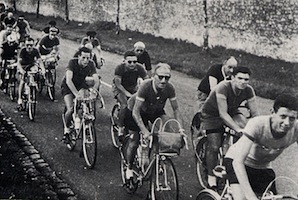 experimentation
with faster speeds, during which there appeared to be no ill
effects on rider completion rates, average speeds of 20 k.p.h
for 200 kilometer brevets and 22.5 k.p.h. for brevets exceeding
200 kilometers were introduced. These average speeds remain the
norm until this day. experimentation
with faster speeds, during which there appeared to be no ill
effects on rider completion rates, average speeds of 20 k.p.h
for 200 kilometer brevets and 22.5 k.p.h. for brevets exceeding
200 kilometers were introduced. These average speeds remain the
norm until this day.
The thinking behind this change was that
higher average speeds would attract younger riders who would
otherwise be attracted by competing cyclo-sportif events. Efforts
were made, as well, to attract and retain strong younger riders
as ride captains. Ride captains were those riders stationed at
the head of the peloton who were charged with the responsibility
of maintaining the average speed for the ride. Often ride captains
rotated their duties, pulling at the head of the peloton for
a period of time until being relieved by other riders charged
with the ride captain role. On longer rides, ride captains received
their rest not by languishing at the rear of the peloton, but
by riding in a support vehicle.
Understanding that the success of Audax
brevet rides depended on the continued enthusiasm of younger
stronger riders, the Club Executive encouraged the participation
of these riders in cyclo-sportif events staged by cycle tourist
clubs. Audax ride captains had a record of outstanding success
at these events during the 1950's and 1960's. Among their competitors
in these events were riders from the Courbevoie-Asnieres and
the Levallois clubs, clubs that would eventually be employed
by the F.F.C.T. to reconstitute the A.C.P.
Among these cyclo-sportif events was the
Polymultipliee of Chanteloup, the hill climb event that had been
among the causes of the rupture of Audax cycling in the years
following the First World War. Other polymultipliee events were
held in Lyons, Clermont-Ferrand, and Dijon. Additional events
in the annual calendar were the 100 kilometers of the Union Sportive
du Metro, Les Boucles de la Seine, the Douze Heures de l'A.S.P.P.,
and the Vignt-Quatre Heures de Paris. The Fleche Veloccio event
organised by the A.C.P. at Easter, was considered to be part
of this cyclo-sportif programme. In 1961, a team of four Audax
ride captains rode 714 kilometers within the 24 hour time limit,
establishing a new distance record. They were to better this
mark by 24 kilometers in 1964. This calendar of cyclo-sportif
events contested by non-race licensed bicycle tourists was curtailed
in 1972 as a result of an agreement between the principal associations
of French cycling, the F.F.C. and the F.F.C.T.
A further initiative to promote the participation
of club members in club events was the creation of the Aigle
d'Or award. This award, initiated in 1950, was to be reserved
for those who had merited recognition through their participation
in Audax cycling brevets rather than the full gamut of Audax
brevets across the (then) four recognized Audax sport disciplines.
The Aigle d'Or was designed to be awarded to those club members
who had completed the full range of Audax brevets between 200
kilometers and 1000 kilometers, Paris-Brest-Paris, and a second
long distance event of 1000 kilometers or more.
Among the first recipients of the award
was Roger Outrequin, by that time President of the Club, and
with whom many of these new club initiatives was associated.
3. A Programme of Raids 1950 - 1960
It was Outrequin who was responsible for
the re-introduction of the Raid event to Audax cycling. The raid
had been a prominent part of the cycling programme of the Audax
Italiano cyclists, who made frequent long distance rides between
cities. There had been some inter-urban cycling events in the
early days of Audax cycling in France as well, but this tradition
had died out in the aftermath of the 1921 breakup.
Outrequin organized the first of the post-war
raids in 1950. This was a 1000 kilometer ride spread over three
days during which the newly instituted average ride speed of
22.5 k.p.h. was maintained. The ride connected Paris with the
Col Des Grands-Bois (now known as the Col De La Republique),
just south of the city of Saint Etienne. The Col is the site
of a monument to Paul De Vivie, the doyenne of French bicycle
tourism. Thirty-one cyclists undertook the ride of which twenty-nine
completed the event successfully. The four ride captains found
periodic relief by riding in the cab of a supporting van.
The success of this event prompted renewed
demand for further events of this kind. Following a hiatus in
1951, a Paris-Brest-Paris year, a raid of 1000 kilometers between
Paris and Nice was scheduled for 1952. This event was attended
by 118 riders of whom 104 finished. The route again ascended
the Col des Grands-Bois where a moment of respect was spent at
the site of De Vivie's monument. At Nice, some of the riders
joined with other cyclists from across France to participate
in the Semaine Federale, an annual event of the F.F.C.T., with
which the Audax raid had been timed to coincide. Again, as in
all of the raid events, the Audax formula of riding at a fixed
moderate speed under the control of a ride captain was observed.
At the end of 1953, Outrequin was ousted
from the club presidency. He left in his wake, however, a framework
for a continuing series of raid events. For 1954, he had laid
the foundations for a ride, together with the A.C.P. to celebrate
the fiftieth anniversary of the first Audax brevet. The ride
was to be a 600 kilometer brevet from Paris to Grenoble, with
an ascent on the following day of the Le Galibier to an assembly
at the foot of the monument erected in the mountain pass to the
memory of Henri Desgrange. Paris-Le Galibier has become an event
celebrated in the Audax calendar every ten years.
He laid the foundations, as well, for a
second Paris-Nice event in 1955. Paris-Nice Audax was to become
a regular part of the riding calendar, an eighth edition was
held in the year 2000 (the last reported in M. Deon's book, the
chronology of which ends in 2004). In addition, before his departure,
Outrequin had sketched the outlines of a raid to be held in 1960
between Paris and Rome which was to be the site of the Olympic
Games in that year. Following the success of the 1960 ride, Audax
riders conducted raids to Munich, site of the 1972 Olympic Games,
to Barcelona's Olympic Games in 1992, and to Athens, home to
the Olympic Games in 2004.
Through time, other long ride events have
been added to the Audax calendar. Bordeaux-Paris was the first
inter-urban road event of the safety bicycle era, and has retained
an importance in the minds of French cyclists for a long time.
Desgrange had refused to permit Audax cyclists to participate
in an event to be parallel to the professional race in the fifties,
a refusal that had prompted Raphael Boutin to create the 600
kilometer brevet event to be held in its stead. The ambition
to hold an Audax event in conjunction with the running of the
professional race was finally realised in 1977. The Audax event
was carried over the 600 kilometer route was carried on even
after the demise of the professional race, with editions occurring
every two to three years to the present day.
In addition to the Paris-Col des Grands-Bois
raid which has been run periodically since the first 1950 edition,
another commemorative ride has been staged several times between
Paris and La Rochelle, the birthplace of the founder of the U.A.C.P.,
Raphael Boutin. More recently, a 1000 kilometer ride has been
organized from Paris to Avignon and Valence. The final day of
this event features an ascent of Mont Ventoux where, in 1983,
a club member lost his life while attempting an early season
solo ascent of the climb. Pierre Kraemer had been a long time
member of the club, a ride captain, a sometime member of the
Executive, and a Super Audax Complet. His body was found in the
snow not far from where he had abandoned his bicycle. A small
memorial has been erected near the spot.
4. Audax Under One Roof: The Birth of the
Union Des Audax Francais
From the outset of the Audax movement,
there had been successive unsuccessful attempts to bring together
the scheduling and approval of the results of Audax brevet events
in the various sports disciplines in one umbrella organisation.
It had been the aim of Henri Desgrange to promote the development
of amateur athletes who were adept across a number of sports
activities. Early attempts to achieve this by grouping Audax
events in one club failed, as did Boutin's attempt to do something
similar in the 1920's. Conditions to achieve this aim proved
to be more propitious in the 1950's.
The hiking programme that had rallied club
members during the War years was continued in the post-War period.
Some club members remained enthusiastic about walking events
even after the of the full cycling calendar, with the result
that the club organised a first 100 kilometer hiking brevet in
1952.
Among those participating in this event
was Maurice Azalet. Azalet turned his attention to the non-cycling
Audax events with the consequence that, in 1954, he became the
second ever Super Audax Complet, the first to achieve this distinction
since the first award of this distinction in the early 1930's.
What the award entailed was the completion of the full gamut
of brevet events in each of the four sports disciplines that,
at that point, were sports in which Audax brevets were organized.
In other words, this meant the completion of 200, 300, 400, 600,
1000, and 1200 kilometer brevets in cycling, 100, 130, and 150
kilometer brevets in walking, a 6 kilometer swim brevet, and
a rowing brevet of 80 kilometers.
In the following year, 1955, Azalet was
elected to the club Executive and given responsibility for scheduling
and organizing walking events. Azalet fulfilled this mandate,
but took it a step beyond. He contacted the person then responsible
for the overall organization of Audax walking brevets in France,
and brought that person into the club. In effect, with this accession
the U.A.C.P. gained the organizational and approval rights for
all walking brevets scheduled in France.
Azalet went further and, again in 1955,
contacted the Societe Nautique de Lagny and the delightfully
named Les Pingouins de la Marne, the bodies charged with organizing
Audax brevets in rowing and swimming respectively. Both clubs
had experienced difficulties in re-launching a brevet programme
in the post-war period. Both proved amenable to handing off their
responsibilities to the U.A.C.P.
Assuming these new responsibilities, the
Union des Audax Cyclistes Parisiens contemplated a change in
name and mandate. These changes were ratified at the club's annual
members' meeting in 1955 to come into effect on January 1, 1956.
The successor organization was named the Union Des Audax Francais.
VI. The Rise and Decline Of Euraudax
1961 - 1985
1. Beginnings of Foreign Interest
The 1951 edition of Paris-Brest-Paris attracted
the attention of cyclists in other European nations, who sought
to emulate the experience of their French cousins. Rides organized
along Audax lines were organized in Belgium in the early 1950's.
These culminated in a 600 kilometer event in 1955 - Brussels-Paris-Brussels.
The Paris-Brest-Paris of the following year saw the first foreign
participation in the Audax event in the form of four Belgian
cyclists. Interest in Audax cycling continued to grow in Belgium
with the result that there were 24 Belgians among the 127 participants
in the Paris-Rome raid event of 1960.
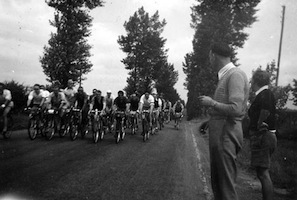
Paris-Brussels-Paris 1961
In early 1961, an accord was reached with
the Royale Ligue Velocipedique Belge (R.L.V.B.) the organisation
that had, by that point, been organizing Audax-style events in
Belgium for a number of years. This accord established a full
brevet series in Belgium, including the 600 kilometer Brussels-Paris-Brussels
organized by the R.L.V.B. but homologated by the French club.
In that year, 269 brevets were submitted to the U.A.F. for homologation.
In the Paris-Brest-Paris Audax of that year, 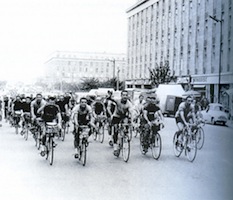 35 of the 162 starters
were either Belgian or Dutch. The first Belgian 1000 kilometer
brevet - a virtual Tour Of Belgium - was staged in the following
year. Subsequent to their participation in that event, 10 Belgians
received the Aigle d'Or designation. 35 of the 162 starters
were either Belgian or Dutch. The first Belgian 1000 kilometer
brevet - a virtual Tour Of Belgium - was staged in the following
year. Subsequent to their participation in that event, 10 Belgians
received the Aigle d'Or designation.
2. The Creation Of Euraudax
From this point forward, Belgian participation
rates began to soar. In 1964, 1374 brevets ridden in Belgium
were homologated. By 1970 more Belgian brevet results were being
homologated than results for the entirety of France - 2221 in
Belgium as opposed to 717 in France. These participation rates
began to be mirrored, to a lesser extent, in the Netherlands
where the first 1000 kilometer brevet was ridden in 1970. This
event attracted 70 starters of whom 14 were French, 11 Belgian,
and 5 residents of Luxembourg.
The year 1970 saw the conclusion of an
agreement between the U.A.F. and the Belgian and the Dutch cycling
federations, the R.L.V.B. and the N.R.T.U. respectively. The
resulting concord, known as the "Charte de L'Euraudax"
came into effect at the beginning of 1971. The accord permitted
each national organization to schedule and homologate events
up to 600 kilometers in distance. The U.A.F. maintained certain
matters under its control, notably the award of the Aigle d'Or
designation and the distribution of control cards.
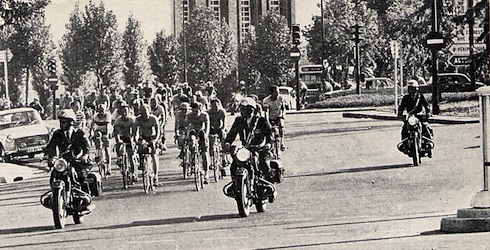
PBP Audax 1971
The accord allowed for the entry of other
nations following a two year probation period. Luxembourg was
accepted as a member later in 1971. German cyclists applied for
admission to Euraudax in 1972, and in 1975 the first Audax brevets
since the demise of Audax Italiano in the 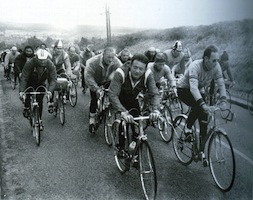 conflagration of the
First World War, were held in Italy. Switzerland sought admission
in 1977 bringing membership in Euraudax to a total of seven nations. conflagration of the
First World War, were held in Italy. Switzerland sought admission
in 1977 bringing membership in Euraudax to a total of seven nations.
3. Decline
The year 1979 marked what was perhaps the
high water mark of Euraudax. In that year, a total of close to
18,200 brevets were reported as homologated across the seven
nation membership. Of these, something over one-third (7906 brevets)
were homologated in France. with the remainder homologated in
the five nations that reported their results.
By this time, however, the first signs
of the decline in European participation began to be observed.
Germany did not report results in 1979 nor, despite periodic
attempts by the French club to stimulate German interest, did
German results reach the levels attained in the first blush of
enthusiasm for Audax cycling. By 1982, neither Switzerland nor
Italy reported results. Homologation of brevets in the remaining
nations began a long slow decline until, by 1995, brevet homologation
was being reported in France and Belgium only. In Belgium, the
full series of brevet events was no longer being offered.
The intervening years have seen periodic
flurries of interest from cyclists in other nations - Portugal,
Sweden, and the United States. This, however, has never amounted
to more than a temporary enthusiasm.
It is hard not to associate the decline
in the fortunes of Euraudax with the creation of the international
institutions of randonneur cycling. The randonneur equivalent
of Euraudax was created some five years after the inception of
the Audax organisation, with Randonneurs Mondiaux succeeding
that organization in 1983, some seven years later. Audax cycling,
however, was unable to accrue to itself the advantages inherent
in being first in the field. Cyclists outside of France clearly
chose to pursue a cycling activity that was closer to cyclo-sportif
riding than to the disciplined group riding favoured by those
who participated in Audax events.
VII. Years Of Leveling Off 1985 - 2004
By the mid-1980's, it was beginning to
become apparent to many in the club that interest in Audax cycling
was beginning to level off. Not simply were the numbers of Audax
brevets organized and homologated falling off, but the average
age of those participating in Audax events was beginning to increase
significantly. Younger cyclists were looking elsewhere to fill
their recreational cycling pursuits.
A number of experiments were undertaken
to counteract these trends. Split brevets were tried - group
cycling outbound and free, or allure libre, cycling on the way
back. This experiment proved satisfying to very few. Similarly,
a few experimental rides 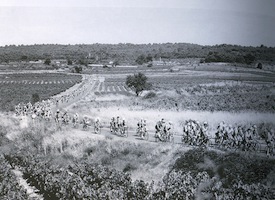 were conducted at a higher average speed
in the hope that a faster speed might attract younger riders.
These trials resulted in chaos on the roads with pelotons fracturing
into many parts. The average speeds established in the early
1950's were quickly re-established. were conducted at a higher average speed
in the hope that a faster speed might attract younger riders.
These trials resulted in chaos on the roads with pelotons fracturing
into many parts. The average speeds established in the early
1950's were quickly re-established.
More successful in stemming the tide of
rider defections were measures taken to reduce the amount of
night cycling involved in riding Audax brevets. Time limits of
the longer brevets were adjusted to permit longer stops at night,
permitting those planning brevet events to minimise or even eliminate
the amount of cycling after dark required to complete a brevet.
A further successful innovation has been
the introduction of the 100 kilometer brevet. When it was first
introduced, though conducted in the Audax manner, the 100 kilometer
ride was informal, that is to say, not homologated. Such had
proven to be the event's popularity, however, that by 1991, the
100 kilometer ride was made into a homologated brevet. It is
considered to be an introduction to Audax cycling and, as such,
is not counted towards any award or qualification. At a time,
however, when participation in other Audax events has declined,
interest in the 100 kilometer event remains strong and gives
a useful bump to the number of Audax events homologated each
year.
VIII. Conclusion
In 2003, members of the Union Des Audax
Francais organized and rode an eleven stage Tour de France. This
event, staged in the centenary year of the inaugural Tour de
France, was held to honour the club's connection with Henri Desgrange,
founder both of the Tour and of Audax cycling in France.
In so doing, the club celebrated its own
heritage and accomplishments over, what is now, more than a century
of organized activities. The club has remained faithful to Desgrange's
original vision of Audax sports events. It promotes physical
health and well being by providing demanding physical challenges
of a non-competitive nature. Though cycling remains the principal
focus of the club's programme, the club has acted to ensure that
Desgrange's original intention that participants in Audax events
be fit and competent across a number of sports disciplines is
encompassed in the club's events calendar.
The club has become both a celebrant and
a repository of cycling tradition. The club's staging of a Paris-Brest-Paris
Audax every five years carries on a cycling event that originates
at the dawn of the modern cycling era. The club's intermittent
participation in the Bordeaux - Paris event does the same thing.
Similarly, events commemorating the memory of great figures of
French cycling - notably Henri Desgrange and Paul De Vivie -
ensure that an important part of the heritage of French cycling
is not lost.
For the club's own members, however, its
principal achievement might lie elsewhere. As Monsieur Deon is
at pains to point out several times in his work, for many members,
the club has been a kind of second family. A social institution
that has provided diversion and comfort for its members and has
endured for over one hundred years, has every right to take pride
in its accomplishments.
October 2009
Photos added September 2012 |